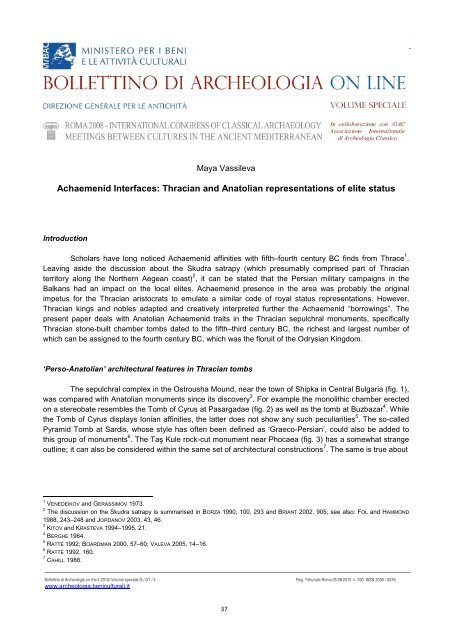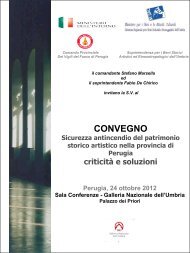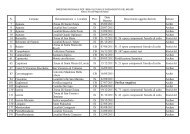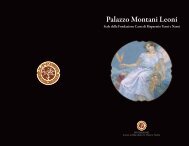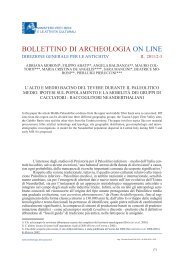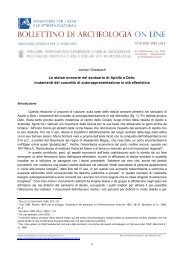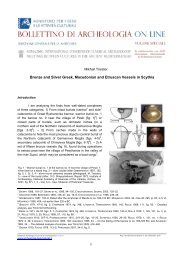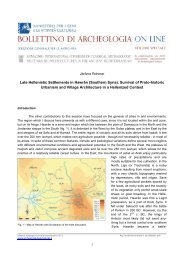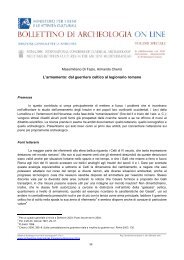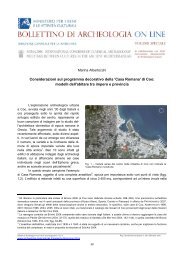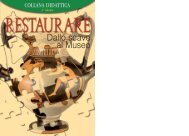Achaemenid Interfaces: Thracian and Anatolian representations of ...
Achaemenid Interfaces: Thracian and Anatolian representations of ...
Achaemenid Interfaces: Thracian and Anatolian representations of ...
Create successful ePaper yourself
Turn your PDF publications into a flip-book with our unique Google optimized e-Paper software.
XVII International Congress <strong>of</strong> Classical Archaeology, Roma 22-26 Sept. 2008<br />
Session: Being ‘Graeco-Persian’<br />
Maya Vassileva<br />
<strong>Achaemenid</strong> <strong>Interfaces</strong>: <strong>Thracian</strong> <strong>and</strong> <strong>Anatolian</strong> <strong>representations</strong> <strong>of</strong> elite status<br />
Introduction<br />
Scholars have long noticed <strong>Achaemenid</strong> affinities with fifth–fourth century BC finds from Thrace 1 .<br />
Leaving aside the discussion about the Skudra satrapy (which presumably comprised part <strong>of</strong> <strong>Thracian</strong><br />
territory along the Northern Aegean coast) 2 , it can be stated that the Persian military campaigns in the<br />
Balkans had an impact on the local elites. <strong>Achaemenid</strong> presence in the area was probably the original<br />
impetus for the <strong>Thracian</strong> aristocrats to emulate a similar code <strong>of</strong> royal status <strong>representations</strong>. However,<br />
<strong>Thracian</strong> kings <strong>and</strong> nobles adapted <strong>and</strong> creatively interpreted further the <strong>Achaemenid</strong> “borrowings”. The<br />
present paper deals with <strong>Anatolian</strong> <strong>Achaemenid</strong> traits in the <strong>Thracian</strong> sepulchral monuments, specifically<br />
<strong>Thracian</strong> stone-built chamber tombs dated to the fifth–third century BC, the richest <strong>and</strong> largest number <strong>of</strong><br />
which can be assigned to the fourth century BC, which was the floruit <strong>of</strong> the Odrysian Kingdom.<br />
‘Perso-<strong>Anatolian</strong>’ architectural features in <strong>Thracian</strong> tombs<br />
The sepulchral complex in the Ostrousha Mound, near the town <strong>of</strong> Shipka in Central Bulgaria (fig. 1),<br />
was compared with <strong>Anatolian</strong> monuments since its discovery 3 . For example the monolithic chamber erected<br />
on a stereobate resembles the Tomb <strong>of</strong> Cyrus at Pasargadae (fig. 2) as well as the tomb at Buzbazar 4 . While<br />
the Tomb <strong>of</strong> Cyrus displays Ionian affinities, the latter does not show any such peculiarities 5 . The so-called<br />
Pyramid Tomb at Sardis, whose style has <strong>of</strong>ten been defined as ‘Graeco-Persian’, could also be added to<br />
this group <strong>of</strong> monuments 6 . The Taş Kule rock-cut monument near Phocaea (fig. 3) has a somewhat strange<br />
outline; it can also be considered within the same set <strong>of</strong> architectural constructions 7 . The same is true about<br />
1 VENEDEIKOV <strong>and</strong> GERASSIMOV 1973.<br />
2 The discussion on the Skudra satrapy is summarised in BORZA 1990, 100, 293 <strong>and</strong> BRIANT 2002, 905; see also: FOL <strong>and</strong> HAMMOND<br />
1988, 243–248 <strong>and</strong> JORDANOV 2003, 43, 46.<br />
3<br />
KITOV <strong>and</strong> KRASTEVA 1994–1995, 21.<br />
4<br />
BERGHE 1964.<br />
5<br />
RATTÉ 1992; BOARDMAN 2000, 57–60; VALEVA 2005, 14–16.<br />
6 RATTÉ 1992, 160.<br />
7 CAHILL 1988.<br />
Bollettino di Archeologia on line I 2010/ Volume speciale G / G1 / 4 Reg. Tribunale Roma 05.08.2010 n. 330 ISSN 2039 - 0076<br />
www.archeologia.beniculturali.it<br />
37
M. Vassileva – <strong>Achaemenid</strong> <strong>Interfaces</strong>: <strong>Thracian</strong> <strong>and</strong> <strong>Anatolian</strong> <strong>representations</strong> <strong>of</strong> elite status<br />
Fig. 2 – The Tomb <strong>of</strong> Cyrus at Pasargadae. (DEDEOĞLU 2003, 82).<br />
good parallel with, the Ostrousha Chamber as<br />
while there is a false door on its short side,<br />
the real entrance is on the longer side,<br />
although <strong>of</strong>f centre 10 .<br />
Parallels with <strong>Anatolian</strong>/Perso-<strong>Anatolian</strong><br />
tombs can also be found in other <strong>Thracian</strong><br />
tombs, both rock-cut tombs <strong>and</strong> stonebuilt<br />
tomb chambers. The connection between<br />
the rock-cut <strong>and</strong> the stone-built tombs in<br />
Thrace has long been discussed. The monolithic<br />
rectangular chambers with pitched ro<strong>of</strong><br />
resemble the Phrygian rock-cut tombs (most <strong>of</strong><br />
which date to the sixth century BC <strong>and</strong> later) 11<br />
8<br />
KLEISS 1996, 135, 138.<br />
9<br />
KARAGÖZ 2007.<br />
10<br />
CAHILL 1988, figs. 5–6, 9.<br />
11<br />
For the Phrygian rock-cut tombs see HASPELS 1971, 112–138.<br />
Bollettino di Archeologia on line I 2010/ Volume speciale G / G1 / 4 Reg. Tribunale Roma 05.08.2010 n. 330 ISSN 2039 - 0076<br />
www.archeologia.beniculturali.it<br />
38<br />
Fig. 1a-b –The Ostrousha tomb: general view <strong>and</strong> the<br />
ceiling. (Courtesy TEMP = Thracological Expedition for<br />
Exploration <strong>of</strong> Tumuli; KITOV 2008, fig. 75).<br />
the rock-cut sarcophagus from Dereyazı 8 . A<br />
reconstruction <strong>of</strong> a similar tomb has recently<br />
been produced on the grounds <strong>of</strong> the architectural<br />
fragments <strong>and</strong> reliefs found at <strong>and</strong><br />
near Daskyleion 9 .<br />
The Ostrousha Tomb chamber displays<br />
a peculiar hybrid nature. It has elements<br />
<strong>of</strong> Greek architecture, like the gabled<br />
ro<strong>of</strong>, the dentils, <strong>and</strong> the funerary bed, but<br />
unusually, it has its entrance on its long side.<br />
A similar architectural solution can be observed<br />
in the Antiphelos (modern Kaş, Lycia) late<br />
fourth century BC Tomb, which is almost<br />
square in plan (4.7 х 4 х 4.5 m), the entrance<br />
being situated on the longer side. To some<br />
extent the Taş Kule monument might be a<br />
Fig. 3 – The Taş Kule rock-cut monument. (DEDEOĞLU 2003, 82).
Fig. 4 – Visiting the monolithic chamber <strong>of</strong> the tomb in the<br />
Golyamata Kosmatka tumulus near Shipka (South Central<br />
Bulgaria) with Dr. Kitov, 2004. (Photo: the author).<br />
Among the stone-built chambers, an<br />
analogous monolithic chamber has recently been<br />
discovered in the Golyama Kosmatka Tumulus,<br />
also near the town <strong>of</strong> Shipka, (fig. 4) 12 . This is not a<br />
freest<strong>and</strong>ing construction as it is incorporated into a<br />
more complex building that follows the design <strong>of</strong><br />
<strong>Thracian</strong> tombs. The chamber comes third in a line<br />
<strong>of</strong> three successive chambers, constructed one<br />
behind another. In this third room were housed all<br />
<strong>of</strong> the grave goods. As the chamber lies<br />
perpendicular to the dromos, its entrance is also on<br />
the long side.<br />
Another parallel with the <strong>Anatolian</strong><br />
architecture <strong>of</strong> <strong>Achaemenid</strong> time is provided by a<br />
painted relief representation <strong>of</strong> a lion, discovered in<br />
the Zhaba Mogila Tumulus, near Strelcha, central<br />
Bulgaria (fourth century BC) (fig. 5) 13 . It is possible<br />
that this triangular relief was one <strong>of</strong> a pair that was<br />
arranged on the pediment <strong>of</strong> a building, or flanking a<br />
door or a niche, as is the case in some Lycian<br />
monuments 14 . A similar arrangement can be seen<br />
on Phrygian rock-cut facades: Arslankaya (sixth<br />
century BC) 15 .<br />
As well, newly discovered tombs in Thrace<br />
have yielded a great number <strong>of</strong> stone doors that<br />
closed the chambers. Their stylistic analysis shows<br />
that their closest parallels are to be found in Asia<br />
Minor 16 . The numerous door like stelai found in<br />
<strong>Achaemenid</strong> Anatolia suggest that the door in the<br />
burial rites <strong>and</strong> ceremonies were important, as were<br />
the ‘blind’ doors on some <strong>of</strong> the rock-cut monuments<br />
17 . Those found at <strong>and</strong> near Daskyleion were<br />
placed in tumulus mantles, usually at their peripheries<br />
XVII International Congress <strong>of</strong> Classical Archaeology, Roma 22-26 Sept. 2008<br />
Session: Being ‘Graeco-Persian’<br />
<strong>and</strong> should probably be associated with commemorative practices 18 . These door stelai have been defined as<br />
Ionian-type doors (initially meant for sanctuaries) with some Persian elements 19 . Other ‘hybrid’ doors John<br />
Boardman terms ‘Lydo-Ionian’: the door frames <strong>of</strong> the Cyrus Tomb, that <strong>of</strong> the blind door at Taş Kule, as well<br />
as those on the towers at Pasargadae <strong>and</strong> Naksh-i-Rustam 20 .<br />
12 KITOV 2005a, 44.<br />
13 KITOV 2008, fig. 26.<br />
14 See e.g. Buildings F <strong>and</strong> H on the Xanthian acropolis: METZGER 1963. For another possible tomb with relief-carved gables near<br />
Daskyleion, see supra N. 9.<br />
15<br />
HASPELS 1971, 87, figs. 186–191.<br />
16<br />
STOYANOVA 2007, 534, 540–541.<br />
17<br />
CAHILL 1988, 495–498.<br />
18<br />
POLAT 2005.<br />
19<br />
BÜSING-KOLBE 1978, 82–83; 119–122.<br />
20 BOARDMAN 2000, 59–60.<br />
Bollettino di Archeologia on line I 2010/ Volume speciale G / G1 / 4 Reg. Tribunale Roma 05.08.2010 n. 330 ISSN 2039 - 0076<br />
www.archeologia.beniculturali.it<br />
39<br />
Fig. 5 – The painted lion relief from the Strelcha tomb.<br />
(KITOV 2008, fig. 26).
M. Vassileva – <strong>Achaemenid</strong> <strong>Interfaces</strong>: <strong>Thracian</strong> <strong>and</strong> <strong>Anatolian</strong> <strong>representations</strong> <strong>of</strong> elite status<br />
Fig. 7 – The hunting scenes on the long side <strong>of</strong> the Çan sarcophagus<br />
(Courtesy B.C. Rose).<br />
Bollettino di Archeologia on line I 2010/ Volume speciale G / G1 / 4 Reg. Tribunale Roma 05.08.2010 n. 330 ISSN 2039 - 0076<br />
www.archeologia.beniculturali.it<br />
40<br />
Thus, the ‘Greek’ or Ionian architectural<br />
elements found in the fifth–fourth<br />
century BC <strong>Thracian</strong> tombs 21 are rather<br />
‘Graeco-Persian’, or ‘Lydo-Ionian’. The idea<br />
that Ionian architects <strong>and</strong> builders constructed<br />
the fourth century <strong>Thracian</strong> tombs<br />
is no longer valid.<br />
Furthermore, the long accepted<br />
Macedonian <strong>and</strong> Greek influence in <strong>Thracian</strong><br />
sepulchral architecture <strong>of</strong> the early<br />
Hellenistic <strong>and</strong> Hellenistic times now seems<br />
not so unidirectional.<br />
The Alex<strong>and</strong>rovo tomb <strong>and</strong><br />
iconographic affinities<br />
Field surveys in the last few years<br />
revealed hundreds <strong>of</strong> tumuli along the<br />
Granicus Valley in the Northern Troad 22 .<br />
During rescue excavations one stone-built<br />
tomb <strong>and</strong> three sarcophagi were unearthed.<br />
One <strong>of</strong> these sarcophagi, a fourth century<br />
BC sarcophagus in a tumulus near Çan,<br />
provides a good opportunity to discuss similar<br />
<strong>Thracian</strong>-Persian <strong>and</strong> ‘Graeco-Persian’<br />
<strong>representations</strong> <strong>of</strong> elite status 23 .<br />
The Çan Sarcophagus, unlike the<br />
other two, which were placed directly in the ground, was placed in a round stone chamber with a false dome.<br />
There is no dromos <strong>and</strong> the entrance was sealed with stone blocks 24 . Two <strong>of</strong> the sarcophagus sides, one<br />
long <strong>and</strong> one short, bear painted reliefs. A battle scene is depicted on the short side: a horseman attacks a<br />
fallen enemy with his spear (fig. 6). The rider is helped by a soldier on foot holding two spears <strong>and</strong> a<br />
machaira (short, curved sword). While the enemy has been identified as Greek, the clothing defines the rider<br />
as Persian 25 . The l<strong>and</strong>scape is schematically rendered by a rocky ground level <strong>and</strong> a leafless tree, near<br />
which the adversary has fallen.<br />
Two hunting scenes occupy the long side <strong>of</strong> the sarcophagus: a stag hunt <strong>and</strong> a boar hunt. The<br />
scenes are divided by a similar tree (fig. 7). The stag hunt is situated on the left-h<strong>and</strong> side <strong>of</strong> the viewer,<br />
while the boar hunt is on the right-h<strong>and</strong> side. The two scenes are colour marked: the left-h<strong>and</strong> one is on a<br />
blue background while the right one is on green. The boar is attacked by two dogs while the horseman aims<br />
his spear at the boar’s eye. The hunter wears Persian costume – long-sleeved cloak <strong>and</strong> anaxyrides (trousers).<br />
21<br />
TSETSKHLADZE 1998.<br />
22<br />
ROSE 2007a, 249; 2007b, 72–74.<br />
23<br />
SEVINÇ ET AL 2001.<br />
24<br />
SEVINÇ ET AL 2001, 385–387, fig. 2; ROSE 2007a, 256, fig. 11; 2007b, 75.<br />
25<br />
Another opinion is that the enemy is a Mysian: MA 2008.<br />
Fig. 6 – The battle scene on the short side<br />
<strong>of</strong> the Çan sarcophagus<br />
(Courtesy B.C. Rose).
The second hunting scene has suffered<br />
bigger damages but two stags chased by two<br />
riding hunters can be distinguished. The<br />
stags are represented much smaller than the<br />
wild boar 26 .<br />
The choice <strong>of</strong> the scenes on the Çan<br />
Sarcophagus provokes a comparison with<br />
some <strong>Thracian</strong> monuments. The boar hunt is<br />
widely represented in <strong>Thracian</strong> toreutics 27 . A<br />
recently found chamber tomb with wall<br />
paintings at the village <strong>of</strong> Alex<strong>and</strong>rovo,<br />
southeastern Bulgaria, provides rich comparative<br />
material 28 . Despite stylistic differences<br />
in the paintings, the visual vocabulary <strong>and</strong><br />
the visual programme <strong>of</strong> both the Alex<strong>and</strong>rovo<br />
Tomb <strong>and</strong> Çan Sarcophagus are very<br />
close (fig. 8). In both cases the paintings<br />
were meant for a round burial chamber or<br />
placed within such a chamber. Battle scenes<br />
are depicted on the smaller surface – above<br />
the chamber entrance at Alex<strong>and</strong>rovo 29 <strong>and</strong><br />
on the short side <strong>of</strong> the Çan Sarcophagus 30 .<br />
A horseman attacks a soldier on foot<br />
who is already on the ground. In the<br />
Alex<strong>and</strong>rovo painting the enemy is not yet<br />
down. In this respect, the <strong>Thracian</strong> scene can<br />
be compared with one on a fragmentary relief<br />
at the Archaeological Museum in Manisa<br />
(from a sarcophagus or from a burial<br />
chamber), where a figure on horseback<br />
attacks a naked opponent on foot, who is<br />
shown shielding himself 31 .<br />
In both cases, the hunting scenes<br />
are shown in a larger space: the dome <strong>of</strong> the<br />
tomb <strong>and</strong> the long side <strong>of</strong> the sarcophagus<br />
respectively. Both on the Çan Sarcophagus<br />
<strong>and</strong> in the Alex<strong>and</strong>rovo paintings the wild<br />
boar is attacked by two dogs: one on his<br />
XVII International Congress <strong>of</strong> Classical Archaeology, Roma 22-26 Sept. 2008<br />
Session: Being ‘Graeco-Persian’<br />
back, biting his neck, the other attacking his belly, a pattern well known from ancient hunting scenes (fig. 9).<br />
There are some iconographic differences, however: the most enigmatic figure on the <strong>Thracian</strong> painting is the<br />
naked man with a double-axe. Besides this, there are four horsemen hunting two boars <strong>and</strong> two stags. They<br />
are helped by a hunter on foot equipped with spears, a machaira <strong>and</strong> a club 32 . The boars are already<br />
wounded, unlike the one on the Çan Sarcophagus where a spear is aimed at the boar’s eye. The <strong>Anatolian</strong><br />
26 SEVINÇ ET AL 2001, 388–395, figs. 4–10; ROSE 2007a, 256–257, fig. 13.<br />
27 MARAZOV 1996, 160–179; 2005, 92–96.<br />
28<br />
KITOV 2001.<br />
29<br />
KITOV 2001, 19–20.<br />
30<br />
SEVINÇ ET AL 2001, 386.<br />
31<br />
POLAT 2001.<br />
32<br />
KITOV 2001, 20–27.<br />
Fig. 8 – The paintings on the dome <strong>of</strong> the Alex<strong>and</strong>rovo tomb<br />
(Die Thraker 2004, 255, fig. 11).<br />
Fig. 9 – One <strong>of</strong> the boar-hunt scenes from the Alex<strong>and</strong>rovo tomb<br />
(After: Die Thraker 2004, 256, fig. 13).<br />
Bollettino di Archeologia on line I 2010/ Volume speciale G / G1 / 4 Reg. Tribunale Roma 05.08.2010 n. 330 ISSN 2039 - 0076<br />
www.archeologia.beniculturali.it<br />
41
M. Vassileva – <strong>Achaemenid</strong> <strong>Interfaces</strong>: <strong>Thracian</strong> <strong>and</strong> <strong>Anatolian</strong> <strong>representations</strong> <strong>of</strong> elite status<br />
Fig. 10 – Detail from the Alex<strong>and</strong>rovo paintings to<br />
show closer the saddle blanket<br />
<strong>of</strong> the <strong>Thracian</strong> hunter<br />
(After: Die Thraker 2004, 257, fig. 14).<br />
boar has a bigger head <strong>and</strong> a shorter muzzle, <strong>and</strong> looks<br />
somewhat clumsier. The outline <strong>of</strong> his body is comparable to<br />
the Near Eastern <strong>representations</strong> <strong>of</strong> lions.<br />
The similarities in the clothing <strong>of</strong> the riding hunters are<br />
even more obvious. All <strong>of</strong> them wear anaxyrides <strong>and</strong> s<strong>of</strong>t shoes<br />
<strong>of</strong> textile or leather. The <strong>Thracian</strong>s are represented as wearing<br />
a ‘Median costume’: two are shown wearing long-sleeved tunics.<br />
The saddle blanket is almost identical with the Persian<br />
horse cloth: it is decorated with a border <strong>of</strong> stepped halfmerlons<br />
(fig.10). Beyond the Çan Sarcophagus, this type <strong>of</strong><br />
saddle blanket is known from the ‘Graeco-Persian’ stele from Çavuşköy 33 , which is a close parallel, as well<br />
as fifth century BC depictions <strong>of</strong> riders on other media in Northwestern Iran <strong>and</strong> Northwestern Anatolia 34 .<br />
Battle <strong>and</strong> hunting scenes can be found on the Persian seals <strong>and</strong> bullae, which provide ‘the universal<br />
iconographic medium’ for imagery transfer, not dissimilar to Greek vases 35 . The series <strong>of</strong> seals with hunting<br />
scenes <strong>and</strong> battles between a Persian <strong>and</strong> a Greek are usually defined as ‘Graeco-Persian’ <strong>and</strong> dated to the<br />
fifth century BC <strong>and</strong> later 36 . They show duels between a horseman <strong>and</strong> a pedestrian, as well as hunting<br />
scenes (figs. 11 <strong>and</strong> 12) 37 . A boar hunt scene can be seen on several <strong>of</strong> the bullae from Daskyleion 38 .<br />
Similarly to the sarcophagus relief, the head <strong>of</strong> the animal is attacked.<br />
Besides the Alex<strong>and</strong>rovo Tomb, the same iconographic schemes can be observed in fourth century<br />
BC <strong>Thracian</strong> art <strong>of</strong> different media. Boar hunt scenes are most popular in minor arts, especially in <strong>Thracian</strong><br />
toreutics. One <strong>of</strong> the famous examples is the silver gilt belt from the village <strong>of</strong> Lovets, North Central Bulgaria<br />
(fig. 13) 39 . Jug No.159 from the Rogozen Treasure (fig. 14) 40 <strong>and</strong> the recently discovered seal ring in Peicho-<br />
33<br />
BORCHHARDT 1968, 206–208; AKURGAL 1961, 172, fig. 119; SEVINÇ ET AL 2001, 398, fig.17.<br />
34<br />
BORCHHARDT <strong>and</strong> BLEIBTREU 2008, Type Ib, 189, pls. 3 <strong>and</strong> 9. Cf. Baughan in these Proceedings, N. 31.<br />
35<br />
BOARDMAN 2000, 153.<br />
36<br />
BOARDMAN 2000, 168–174.<br />
37<br />
BOARDMAN 2000, 158, 171, figs 5.38, 5.39, 5.46.<br />
38<br />
KAPTAN 2002, 153–155, DS 94–97, 99; DS188, 189.<br />
39<br />
MARAZOV 1998, no. 105, Fig. 59, 13 175. – Silver gilt belt from Lovets, central Bulgaria (Die Thraker 2004, 318, fig. 3).<br />
40<br />
MARAZOV 1989, 188–189, no. 159.<br />
Bollettino di Archeologia on line I 2010/ Volume speciale G / G1 / 4 Reg. Tribunale Roma 05.08.2010 n. 330 ISSN 2039 - 0076<br />
www.archeologia.beniculturali.it<br />
42<br />
Figg. 11-12 – Impression <strong>of</strong> a Persian seal<br />
(BOARDMAN 2000, fig. 5.39)<br />
<strong>and</strong> Persian seal (BOARDMAN 2000, fig. 5. 46).
va Mogila near Starosel, Central Bulgaria (fig.<br />
15) 41 can be added to the examples. The bronze<br />
statue <strong>of</strong> a boar, probably part <strong>of</strong> a statuary<br />
group, found in Mezek near the Bulgarian-Turkish<br />
border, now in the Istanbul Museum, also<br />
shows a wounded boar 42 . In the toreutics, <strong>of</strong>ten<br />
the animal is wounded with two spears, or one is<br />
still in the air.<br />
The semantics <strong>of</strong> the hunting scenes<br />
have been discussed, including <strong>Achaemenid</strong><br />
<strong>and</strong> Indo-European parallels 43 . Scholars have<br />
long detected the meaningful iconographic<br />
differen-ces between the hunting scenes in<br />
Greece <strong>and</strong> in the Near East. Hunting a wild<br />
boar or a stag on horseback depicted on sixth<br />
century BC Greek vases is a collective event, a<br />
suite <strong>of</strong> young men (ephebes) chasing the<br />
animal 44 . Representations <strong>of</strong> a hunt on<br />
horseback practi-cally disappeared from vase<br />
painting in the early fifth century BC. Now, it is a<br />
lonely hunter on foot that is depicted, most <strong>of</strong>ten<br />
identified as Meleager 45 .<br />
Earlier scenes <strong>of</strong> royal hunts <strong>and</strong> duels<br />
existеd in Anatolia <strong>and</strong> in the Near East 46 , as did<br />
earlier mythological texts on the subject 47 . The<br />
king is depicted as hunting lions from a chariot<br />
on the Assyrian reliefs. Recently, the role <strong>of</strong> the<br />
hunt in Hittite royal ideology has been<br />
discussed. Hittite texts from Tudhalyias IV’s<br />
reign (thirteenth century BC) reveal that the hunt<br />
was related to the claim <strong>and</strong> reclaim <strong>of</strong> a certain<br />
territory by the royal power 48 . They are related to<br />
the royal/aristocratic trial that led to the renewal<br />
<strong>and</strong> consolidation <strong>of</strong> the royal power 49 . The king<br />
thus associates himself with the heroic past.<br />
The boar depicted on the Rogozen Jug<br />
is almost as big as the hunters’ horses. Thus, it<br />
has been suggested that a supernatural animal<br />
XVII International Congress <strong>of</strong> Classical Archaeology, Roma 22-26 Sept. 2008<br />
Session: Being ‘Graeco-Persian’<br />
is represented, which the ruler/aristocrat should face <strong>and</strong> overcome 50 . Here the most <strong>of</strong>ten quoted ancient<br />
text is Herodotus’ passage on the boar hunt in which Atys, Croesus’ son was killed (1.36–43). This monstruous<br />
41<br />
KITOV 2003, 16, fig. 71.<br />
42<br />
VENEDIKOV <strong>and</strong> GERASSIMOV 1973, fig. 60.<br />
43<br />
MARAZOV 1996, 160–179.<br />
44<br />
DURAND <strong>and</strong> SCHNAPP 1989, 61–65.<br />
45<br />
DURAND <strong>and</strong> SCHNAPP 1989, 65–69.<br />
46<br />
HEIMPEL <strong>and</strong> TRÜPELMANN 1977.<br />
47<br />
WEST 1999, 373–374.<br />
48<br />
HAWKINs 2006.<br />
49<br />
MARAZOV 1996, 179; 2005.<br />
50<br />
MARAZOV 1996, 161.<br />
Bollettino di Archeologia on line I 2010/ Volume speciale G / G1 / 4 Reg. Tribunale Roma 05.08.2010 n. 330 ISSN 2039 - 0076<br />
www.archeologia.beniculturali.it<br />
43<br />
Fig. 14 – Detail <strong>of</strong> jug No.159 from the Rogozen treasure<br />
(MARAZOV 1996, fig. 124).<br />
Fig. 15 – The bezel <strong>of</strong> the gold seal-ring from the Peychova tumulus<br />
showing boar-hunt on horseback.<br />
(KITOV 2005b, 35, fig. 38).
M. Vassileva – <strong>Achaemenid</strong> <strong>Interfaces</strong>: <strong>Thracian</strong> <strong>and</strong> <strong>Anatolian</strong> <strong>representations</strong> <strong>of</strong> elite status<br />
animal was devastating the Mysian l<strong>and</strong>s. In describing the hunt, Herodotus speaks about ‘picked men’ (1.<br />
36): obviously, young noble men who would attack the wild boar, helped by dogs. On the one h<strong>and</strong>, this<br />
hunting episode resembles the initiation <strong>of</strong> the ephebes, but on the other, it comes close to the trial <strong>of</strong> the<br />
king-to-be. Adonis being killed by a boar in the Calydonian Boar Hunt furnishes another mythological<br />
example (Theocr. Id. 30, Ovid. Metam. 10.710, Apollod. 3.14.4, Macr. Sat. 1.21.4) 51 .<br />
Both the <strong>Achaemenid</strong> <strong>Anatolian</strong> <strong>and</strong> the <strong>Thracian</strong> hunting scenes fall within this tradition <strong>of</strong> hybrid<br />
hunting scenes which, designed primarily for sepulchral monuments, can be linked with the ‘Eastern’ royal<br />
ideological tradition. In the Çan Sarcophagus <strong>and</strong> in the Alex<strong>and</strong>rovo Tomb the hunt is given more space<br />
<strong>and</strong> is thus more important than the battle scene 52 . This could mean that the hunt was ideologically more<br />
important for the <strong>Anatolian</strong> <strong>and</strong> <strong>Thracian</strong> aristocrats. The sarcophagus <strong>and</strong> the <strong>Thracian</strong> tomb painting have<br />
important differences, which relate to their cultural contexts, but they also share important features which link<br />
the <strong>Thracian</strong> <strong>and</strong> Western <strong>Anatolian</strong> spheres.<br />
Conclusion<br />
It was 20 years ago when Machteld Mellink noted: “The syncretism <strong>of</strong> the Greek, West <strong>Anatolian</strong> <strong>and</strong><br />
Persian art is noticeable from Thrace to inner Lycia” 53 . Although <strong>Anatolian</strong> <strong>and</strong> <strong>Achaemenid</strong> affinities have<br />
long been recognised in <strong>Thracian</strong> tombs, specific comparisons more effectively situate the <strong>Thracian</strong> visual<br />
repertoire. The most compelling examples are to be found in the fourth century BC stone-built <strong>Thracian</strong><br />
tombs <strong>and</strong> vessels made out <strong>of</strong> precious metals. The monuments discussed above reveal similarities in the<br />
representation <strong>of</strong> elite status in fourth century BC Thrace <strong>and</strong> <strong>Achaemenid</strong> Anatolia.<br />
The Western <strong>Anatolian</strong> monuments to which the <strong>Thracian</strong> monuments have been compared were<br />
products <strong>of</strong> a provincial satrap aristocracy or the local Persianized elite. In the past, they have been called<br />
‘Graeco-Persian’. This term has recently been much criticised <strong>and</strong> for good reason 54 . There are no good<br />
parallels from Persia proper for either <strong>Anatolian</strong> or <strong>Thracian</strong> monuments. Both the locals <strong>and</strong> the Persians<br />
interacted with the East Greeks. Scholars now prefer to use ‘emulation’ to denote a process <strong>of</strong> adopting,<br />
adapting <strong>and</strong> creation 55 . This term may be helpful in underst<strong>and</strong>ing the creation <strong>of</strong> <strong>Thracian</strong> monuments <strong>of</strong><br />
<strong>Achaemenid</strong> inspiration. The models that <strong>Thracian</strong> aristocracy emulated were ‘Graeco-Persian’, Ionian or<br />
‘Lydo-Ionian’ – that is, models from Western Anatolia rather than Persia itself. Proximity <strong>and</strong> similarities in<br />
the social structure <strong>of</strong> Thrace <strong>and</strong> <strong>Achaemenid</strong> Anatolia must have facilitated this emulation at this Western<br />
<strong>Achaemenid</strong> interface.<br />
51 VIDAL-NAQUET 1983, 170.<br />
52 SEVINÇ ET AL 2001, 401.<br />
53 MELLINK 1988, 221.<br />
54 ROOT 1991, 22, KAPTAN 2002: 2–4; MILLER 2006.<br />
55 MILLER 2007, 66–67.<br />
Bollettino di Archeologia on line I 2010/ Volume speciale G / G1 / 4 Reg. Tribunale Roma 05.08.2010 n. 330 ISSN 2039 - 0076<br />
www.archeologia.beniculturali.it<br />
44<br />
Dr. Maya Vassileva<br />
Center <strong>of</strong> <strong>Thracian</strong> Studies<br />
Bulgarian Academy <strong>of</strong> Sciences<br />
13, Moskovska Street<br />
S<strong>of</strong>ia 1000<br />
Bulgaria
Bibliography<br />
XVII International Congress <strong>of</strong> Classical Archaeology, Roma 22-26 Sept. 2008<br />
Session: Being ‘Graeco-Persian’<br />
AKURGAL E., 1961. Die Kunst Anatoliens von Homer bis Alex<strong>and</strong>er. Berlin.<br />
BERGHE L.V., 1964. Le tombeau achéménide de Buzpar. In K. BITTEL (ed), Vorderasiatische Archäologie.<br />
Berlin, 243–258.<br />
BOARDMAN J., 2000. Persia <strong>and</strong> the West. An archaeological investigation <strong>of</strong> the genesis <strong>of</strong> <strong>Achaemenid</strong> art.<br />
London.<br />
BORCHHARDT J., 1968. Epichorische, gräko-persisch beeinflußte Reliefs in Kilikien. IstMitt, 18, 161–211.<br />
BORCHHARDT J. <strong>and</strong> BLEIBTREU E., 2008. Von der Pferdedecke zum Sattel. Antike Reitkunstzwischen Ost und<br />
West. In İ. DELEMEN, S. ÇOKAY-KEPÇE, A. ÖZDIZBAY <strong>and</strong> Ö. TURAK (eds), Euergetes. Festschrift für<br />
Pr<strong>of</strong>. Dr. Haluk Abbasoğlu zum 65. Geburtstag. Part 1. Antalya, 167–215.<br />
BORZA E.N., 1990. In the Shadow <strong>of</strong> Olympus. The Emergence <strong>of</strong> Macedon. Princeton.<br />
BRIANT P., 2002. From Cyrus to Alex<strong>and</strong>er: A history <strong>of</strong> the Persian Empire. Winona Lake, Ind.<br />
BÜSING-KOLBE A., 1978. Frühe griechische Türen. JDAI, 93, 66–174.<br />
CAHILL N., 1988. Taş Kule: A Persian-Period Tomb near Phokaia. AJA, 92.4, 481–501.<br />
DEDEOĞLU H., 2003. The Lydians <strong>and</strong> Sardis. Istanbul.<br />
Die Thraker. Das goldene Reich des Orpheus (exhibition catalogue). 2004. Bonn.<br />
DURAND J.-L. <strong>and</strong> SCHNAPP A., 1989. Sacrificial Slaughter <strong>and</strong> Initiatory Hunt. In CL. BÉRARD, CHR. BRON, J.-<br />
L. DURAND, F. FRONTISI-DUCROUX, F. LISSARRAGE, A. SCHNAPP <strong>and</strong> J.-P. VERNANT (eds), A City <strong>of</strong><br />
Images. Iconography <strong>and</strong> society in Ancient Greece. Translated by D. Lyons. Princeton, 53–70.<br />
FOL A. <strong>and</strong> HAMMOND N.G.L., 1988. Persia in Europe, apart from Greece. In J. BOARDMAN, N.G.L. HAMMOND,<br />
D.M. LEWIS <strong>and</strong> M. OSTWALD (eds), CAH IV 2 : Persia, Greece <strong>and</strong> the Western Mediterranean c. 525 to<br />
479 BC. Cambridge, 234–253.<br />
HASPELS C.H.E., 1971. The Phrygian Highl<strong>and</strong>s. Sites <strong>and</strong> Monuments 2 vols. Princeton.<br />
HAWKINS J.D., 2006. Tudhaliya the Hunter. In TH. P. J. VAN HOUT with the assistance <strong>of</strong> C.H. VAN ZOEST (eds),<br />
The Life <strong>and</strong> Times <strong>of</strong> Hattušili III <strong>and</strong> Tuthaliya IV. Proceedings <strong>of</strong> a Symposium held in honour <strong>of</strong> J.<br />
de Roos, 12-13 December 2003, Leiden. Leiden, 49–76.<br />
HEIMPEL W. und TRÜPELMANN L., 1977. Jagd. In Reallexicon der Assyriologie und Vorderasiatischen<br />
Archäologie 5/3–4. Berlin, 234–238.<br />
JORDANOV K., 2003. <strong>Achaemenid</strong>o-Persica: Attempts at Political <strong>and</strong> Administrative Control (ca. 515–466<br />
BC). Thracia, 15, 39–54.<br />
KAPTAN D., 2002. The Daskyleion Bullae: Seal images from the Western <strong>Achaemenid</strong> Empire (<strong>Achaemenid</strong><br />
History XII). Leiden.<br />
KARAGÖZ Ş., 2007. Neue Ansichten zu einem freistehenden Grabbau aus Daskyleion. In İ. DELEMEN, O.<br />
CASABONNE, Ş. KARAGÖZ <strong>and</strong> O. TEKIN (eds), The <strong>Achaemenid</strong> Impact on Local Populations <strong>and</strong><br />
Cultures in Anatolia (Sixth–Fourth Centuries BC). Istanbul, 195–214.<br />
KITOV G., 2001. A Newly Found <strong>Thracian</strong> Tomb with Frescoes. Archaeologia Bulgarica, 5 (2), 15–29.<br />
KITOV G., 2003. Starosel – centre cultuel thrace (Preliminaires). Orpheus, 11–12, 5–60.<br />
KITOV G., 2005a. The Newly Discovered Tomb <strong>of</strong> the <strong>Thracian</strong> Ruler Seuthes III. Archaeologia Bulgariaca, 9<br />
(2), 39–54.<br />
KITOV G., 2005b. The Valley <strong>of</strong> the <strong>Thracian</strong> Rulers. Varna.<br />
KITOV G., 2008. Mogili, khramove, grobnitsi. S<strong>of</strong>ia.<br />
KITOV G. <strong>and</strong> KRASTEVA M., 1994–1995. The <strong>Thracian</strong> Grave <strong>and</strong> Cult Complex in the Ostrousha Tumulus<br />
near Shipka. Talanta, 26–27, 7–28.<br />
KLEISS W., 1996. Bemerkungen zum “Pyramid Tomb” in Sardes. IstMitt, 46, 135–140.<br />
MA J., 2008. Mysians on the Çan Sarcophagus? Ethnicity <strong>and</strong> domination in Achaimenid military art. Historia,<br />
30 1–16.<br />
MARAZOV I., 1989. The Catalogue. In A. FOL (ed), The Rogozen Treasure. S<strong>of</strong>ia, 138–194.<br />
MARAZOV I., 1996. The Rogozen Treasure. S<strong>of</strong>ia.<br />
Bollettino di Archeologia on line I 2010/ Volume speciale G / G1 / 4 Reg. Tribunale Roma 05.08.2010 n. 330 ISSN 2039 - 0076<br />
www.archeologia.beniculturali.it<br />
45
M. Vassileva – <strong>Achaemenid</strong> <strong>Interfaces</strong>: <strong>Thracian</strong> <strong>and</strong> <strong>Anatolian</strong> <strong>representations</strong> <strong>of</strong> elite status<br />
MARAZOV I. (ed), 1998. Ancient Gold. The Wealth <strong>of</strong> the <strong>Thracian</strong>s. New York.<br />
MARAZOV I., 2005. The <strong>Thracian</strong> Warrior. S<strong>of</strong>ia.<br />
MELLINK M.J., 1988. Anatolia. In J. BOARDMAN, N.G.L. HAMMOND, D.M. LEWIS <strong>and</strong> M. OSTWALD (eds), CAH<br />
IV 2 : Persia, Greece <strong>and</strong> the Western Mediterranean c. 525 to 479 BC. Cambridge, 211–233.<br />
METZGER H., 1963. Fouilles de Xanthos 2. L'acropole Lycienne. Paris.<br />
MILLER M.C., 2006. Betwixt <strong>and</strong> Between: Western Anatolia in the Persian Period. In C.C. MATTUSCH, A.A.<br />
DONOHUE <strong>and</strong> A. BRAUER (eds), Proceedings <strong>of</strong> the XVIth International Congress <strong>of</strong> Classical<br />
Archaeology, Boston, August 23–26, 2003. Oxford, 225–227.<br />
MILLER M.C., 2007. The Poetics <strong>of</strong> Emulation in the <strong>Achaemenid</strong> World: The Figured Bowls <strong>of</strong> the ‘Lydian<br />
Treasure’. AWE, 6, 43–72.<br />
POLAT G., 2001. Das Grabdenkmal des Autophradates. In T. BAKIR (ed), <strong>Achaemenid</strong> Anatolia. Proceedings<br />
<strong>of</strong> the First International Symposium on Anatolia in the <strong>Achaemenid</strong> Period. B<strong>and</strong>irma 15–18 August<br />
1997. Leiden, 123–133.<br />
POLAT G., 2005. Bir Anadolu-Akhaemenid dönemi ölü kültü geleneği: tümülüs önünde steller ve seremoni<br />
alanları. Olba, 11, 1–23.<br />
ROOT M.C., 1991. From the Heart: Powerful Persianisms in the Art <strong>of</strong> the Western Empire. In H. SANCISI-<br />
WEERDENBURG <strong>and</strong> A. KUHRT (eds), Asia Minor <strong>and</strong> Egypt: Old cultures in a new empire. Proceedings<br />
<strong>of</strong> the Groningen 1988 <strong>Achaemenid</strong> History Workshop (<strong>Achaemenid</strong> History VI). Leiden, 1–29.<br />
RATTÉ C., 1992. The ‘Pyramid Tomb’ at Sardis. IstMitt, 42, 135–161.<br />
ROSE B.C., 2007a. The Tombs <strong>of</strong> the Granicus River Valley. In İ. DELEMEN, O. CASABONNE, Ş. KARAGÖZ <strong>and</strong><br />
O. TEKIn (eds), The <strong>Achaemenid</strong> Impact on Local Populations <strong>and</strong> Cultures in Anatolia (Sixth–Fourth<br />
Centuries BC). Istanbul, 249–266.<br />
ROSE B.C., 2007b. Granicus River Valley Survey Project, 2004–2005. Studia Troica, 17, 65–150.<br />
SEVINÇ N., KÖRPE R., TOMBUL M., ROSE C. B., STRAHAN D., KIESEWETTER H. <strong>and</strong> WALLRODT J., 2001. A New<br />
Painted Graeco-Persian Sarcophagus from Çan. Studia Troica, 11, 383–420.<br />
STOYANOVA D., 2007. The Greek Door in the Tomb Architecture <strong>of</strong> Macedonia, Thrace <strong>and</strong> Asia Minor. In D.<br />
KAPLANIDOU <strong>and</strong> I. CHIOTI (eds), Ancient Macedonia VII. Macedonia from the Iron Age to the Death <strong>of</strong><br />
Philip II. Papers read at the Seventh International Symposium Held in Thessaloniki, October 14–18,<br />
2002. Thessaloniki, 531–550.<br />
TSETSKHLADZE G.R., 1998. Who built the Skythian <strong>and</strong> <strong>Thracian</strong> royal <strong>and</strong> elite tombs? Oxford Journal <strong>of</strong><br />
Archaeology, 17 (1), 55–92.<br />
VALEVA J., 2005. The Painted C<strong>of</strong>fers <strong>of</strong> the Ostrusha Tomb. S<strong>of</strong>ia.<br />
VENEDIKOV I. <strong>and</strong> GERASSIMOV T., 1973. <strong>Thracian</strong> Art. S<strong>of</strong>ia.<br />
VIDAL-NAQUET P., 1983. Le chasseur noir. Formes de pensée et formes de société dans le monde grec.<br />
Paris.<br />
WEST M., 1999. The East Face <strong>of</strong> Helicon. Oxford.<br />
Bollettino di Archeologia on line I 2010/ Volume speciale G / G1 / 4 Reg. Tribunale Roma 05.08.2010 n. 330 ISSN 2039 - 0076<br />
www.archeologia.beniculturali.it<br />
46


